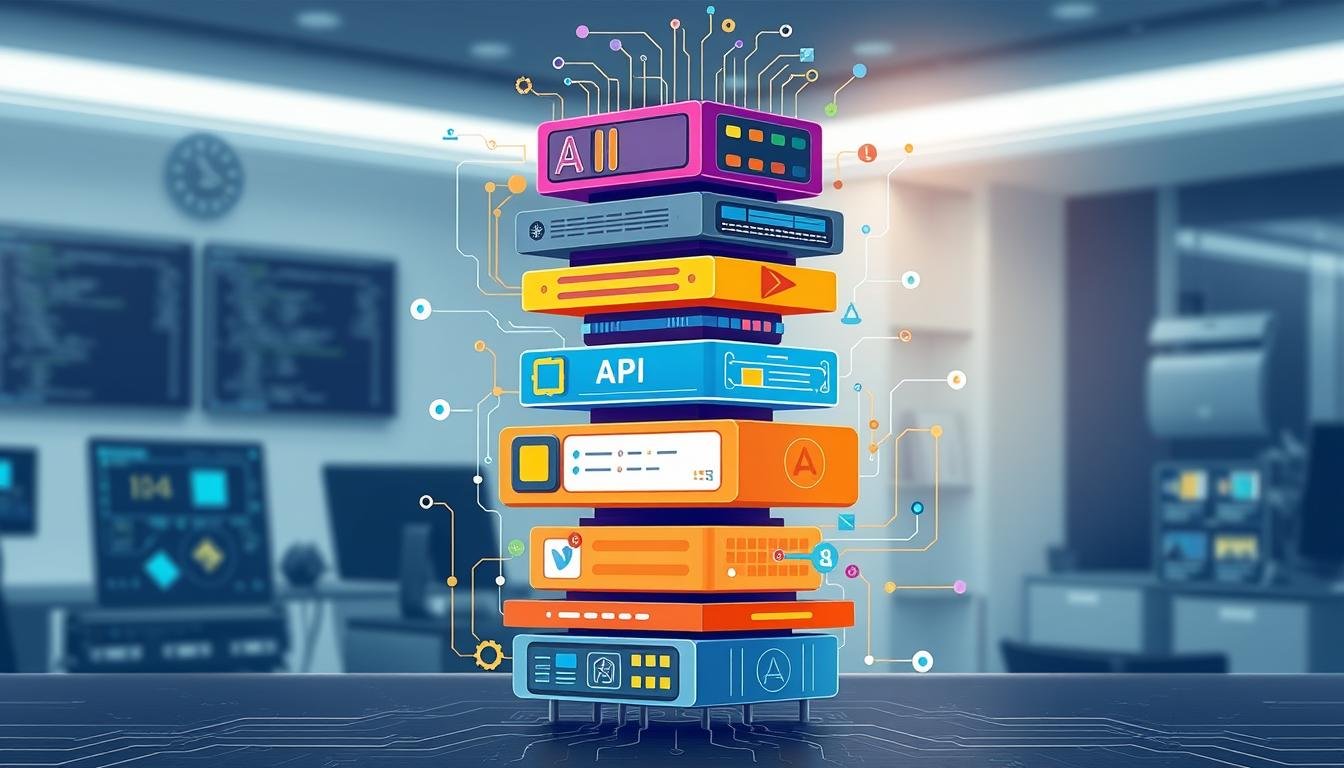A tech stack is vital in software development. It’s a mix of tools used to build digital products.
Understanding tech stacks can make or break projects. Knowing how to pick the right one is key.
This is a visually striking illustration of a tech stack featuring layered components such as databases, servers, APIs, front-end frameworks, and programming languages. Each layer is represented by distinct shapes and colors arranged vertically, showcasing interconnected lines and digital elements that symbolize data flow. The background should be a sleek, modern workspace with hints of technology, like circuit patterns or abstract digital motifs.
This guide covers tech stack basics for developers. We’ll explore key parts and popular choices.
You’ll learn how to build a great tech stack. This knowledge will help your projects succeed.
Understanding the Concept of a Tech Stack
A tech stack is a mix of software and languages used to create applications. It’s the blueprint for building digital solutions that power businesses and projects.
A tech stack has many working parts, including the operating system, web server, and database management system.
Programming languages, frameworks, and libraries are also part of the stack. The project’s needs and the team’s skills guide the choice of these parts.
The tech stack choice affects how software is made. It impacts the app’s growth, speed, and overall development costs.
Picking the right stack needs careful thought—factors like speed, security, and support matter when deciding.
Knowing about tech stacks helps developers make wise choices. They can build strong apps that meet changing business needs.
Components of a Tech Stack Explained
A tech stack is a group of tools for building apps. It includes front-end, back-end, database, and DevOps technologies.
The front-end layer focuses on what users see and interact with. It uses HTML, CSS, JavaScript, and frameworks like React or Angular.
Back-end technologies handle server-side tasks and data processing. They include languages like Python or Java with frameworks such as Django.
Database systems store and manage data. Relational databases like MySQL are common.
NoSQL databases like MongoDB offer flexible data models. They’re gaining popularity for their scalability.
DevOps tools automate software development tasks. Git, Jenkins, and Docker help streamline the process.
These components work together to create a robust tech stack. They support the development of complex applications efficiently.
Popular Tech Stacks in the Industry
Developers use many tech stacks. Each stack has its benefits and uses.
Let’s look at some popular tech stacks. We’ll explore LAMP, MEAN, and MERN stacks.
LAMP stands for Linux, Apache, MySQL, and PHP. It’s an open-source stack for web development.
LAMP is excellent for making dynamic websites. It’s known for being reliable and easy to scale.
MEAN includes MongoDB, Express.js, Angular, and Node.js. It’s suitable for making modern, single-page apps.
MEAN uses JavaScript for all parts. This makes it popular with many developers.
MERN is like MEAN but uses React instead of Angular. React is known for its suitable user interfaces.
MERN is excellent for making dynamic web apps. It’s a strong choice for many projects.
Choose a stack based on your project needs. Think about your team’s skills and long-term plans.
Understanding these stacks helps you make good choices. This can lead to success in your project.
Factors to Consider When Choosing a Tech Stack
Picking the right tech stack is crucial for software development. It’s about matching technologies with project needs and team skills.
Let’s explore key factors for building your tech stack.
First, assess your project’s tech stack selection criteria. What core functions do you need to deliver?
Consider performance, security, and reliability requirements. Analyze your project’s goals to ensure your tech stack supports them.
Next, evaluate your team skills assessment. Can your team work with the technologies you’re considering?
If not, are you ready to invest in training? Matching the tech stack to your team’s skills boosts efficiency.
Lastly, think about project scalability. Your tech stack must grow with your user base and data volumes.
Check each component’s scalability to ensure future growth. This helps your solution expand smoothly.
Careful planning builds a tech stack that meets current and future needs. It creates a strong foundation for your application.
How to Build Your Own Tech Stack
Creating a custom tech stack is exciting. It lets you choose tools that fit your project’s needs.
Start by examining your project’s requirements. Then, consider your team’s skills and what tech is available.
Next, explore different technologies and platforms. Look at programming languages, frameworks, databases, and deployment tools.
Research each part carefully. Consider if it can grow, be easy to maintain, and work with other tools.
Be ready to try new things as you build. Test different options and make changes as needed.
Stay flexible as technology keeps changing. This helps keep your tech stack up-to-date.
Building a custom tech stack is fun. It helps your project reach its full potential.
Emerging Technologies in Tech Stacks
Software development is constantly changing. New tech is reshaping how we build programs. Serverless architecture and microservices are two big game-changers.
Serverless computing lets developers focus on making apps. They don’t have to worry about managing servers, which saves them time and money.
Microservices break big apps into smaller parts. This makes it easier for apps to grow and change.
AI is also becoming a big part of coding. AI tools can write code and find bugs automatically.
These new tools help developers work faster. They also help make better software.
These new techs are changing how we build apps. They’re making coding more efficient and innovative.
As they grow, they’ll shape the future of software, giving developers new ways to create amazing programs.
Common Mistakes in Tech Stack Selection
Developers often need to pay more attention to tech stack scalability. When user demands increase, this can lead to system failures.
New technologies can be exciting but may require extensive expertise. Choosing complex tech stacks can result in unnecessary costs and delays.
Overcomplicating the tech stack is a common problem. Too many technologies can make a system hard to maintain.
When selecting a tech stack, prioritize scalability. Match the stack to your team’s skills and keep it simple.
A well-chosen tech stack supports long-term project success. It should be resilient, efficient, and adaptable to changes.
Maintaining and Updating Your Tech Stack
Keeping your tech stack current is vital for team productivity. Regular maintenance involves assessing tools and implementing necessary updates.
Staying informed about the latest technology trends is crucial. This ensures your tech stack remains relevant to your business needs.
New programming languages or cloud services can boost team efficiency. These updates can improve your applications’ overall performance.
A digital workspace filled with modern technology tools showcases a developer analyzing code on a computer screen, surrounded by floating icons representing various software components. Gears and circuit patterns in the background symbolize maintenance and updates, vibrant colors, and a futuristic atmosphere.
Investing in developer training is key to a healthy tech stack. This will help your team adapt to changes and explore new solutions.
A proactive approach equips your team with essential tools and knowledge, leading to high-quality, efficient, and secure solutions.
Improved tech stacks can enhance customer experiences. They also increase competitiveness and drive long-term business growth.
Conclusion: The Future of Tech Stacks
Tech stacks are changing fast. New techs like AI and machine learning are changing how we make software.
Devs need to keep learning. This helps them stay up-to-date with new trends.
Adding new tools to tech stacks is key. It helps companies stay ahead of others.
Bright tech leaders pick flexible tools. This lets teams use the newest tech easily.
Low-code platforms are growing. They let non-tech people help make software, too.
The future of tech stacks looks bright. It will mix human smarts with cool new tech.
FAQ
What is a tech stack?
A tech stack combines software products and programming languages. It creates web or mobile apps using front-end, back-end, and supporting tools.
Why is understanding a tech stack important?
Knowledge of the tech stack helps developers select the right tools for projects. It affects app performance, scalability, and development efficiency.
What are the standard components of a tech stack?
Tech stacks include front-end, back-end, database, and DevOps tools. The front end uses HTML, CSS, and JavaScript frameworks like React.
The back end may use Python, Java, or Node.js. Databases include MySQL and MongoDB.
How do I choose the right tech stack for my project?
When picking a stack, consider project needs, team skills, and future goals. Weigh the pros and cons of options to find the best fit.
What are some popular tech stacks used in the industry?
LAMP, MEAN, and MERN are widely used tech stacks. The choice depends on project needs and team expertise.
How can I stay up-to-date with the latest tech stack trends?
Follow blogs, attend events, and join online dev communities. Keep learning about new tech and frameworks.
Regularly review your tech stack and adapt to helpful new trends.
you may also read:Yandex.com VPN Video Full Bokeh Lights APK Download for Android: The Ultimate Guide

